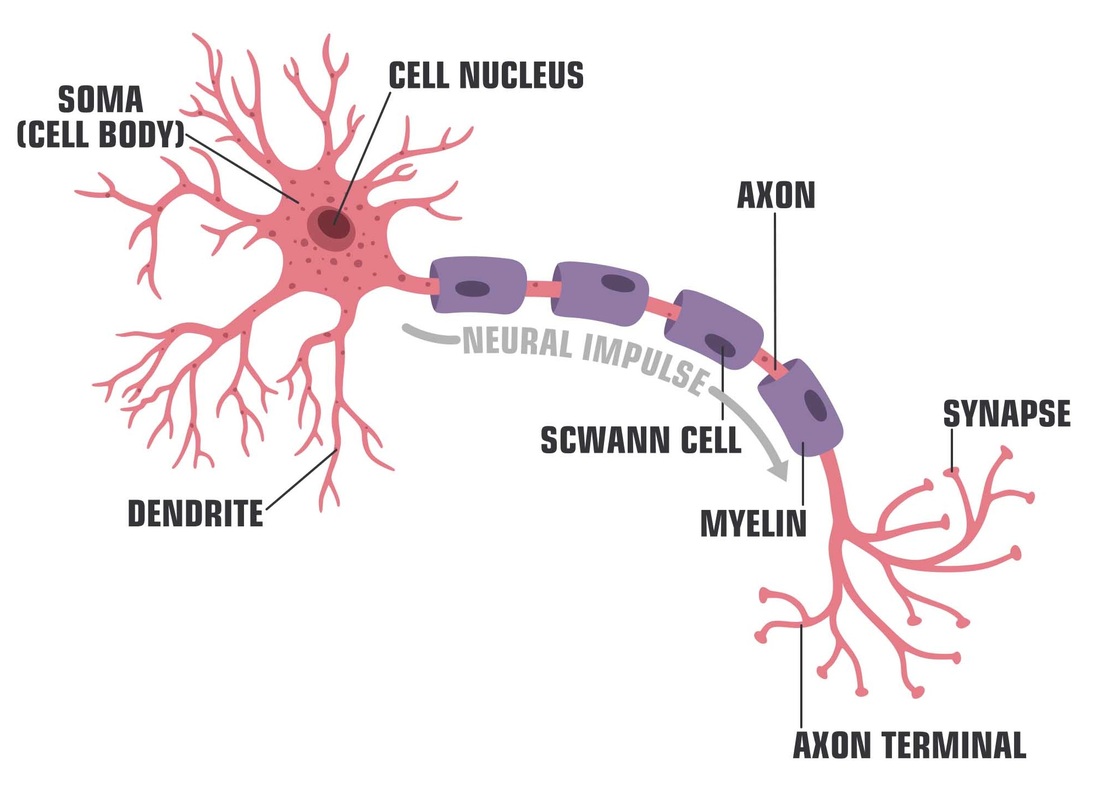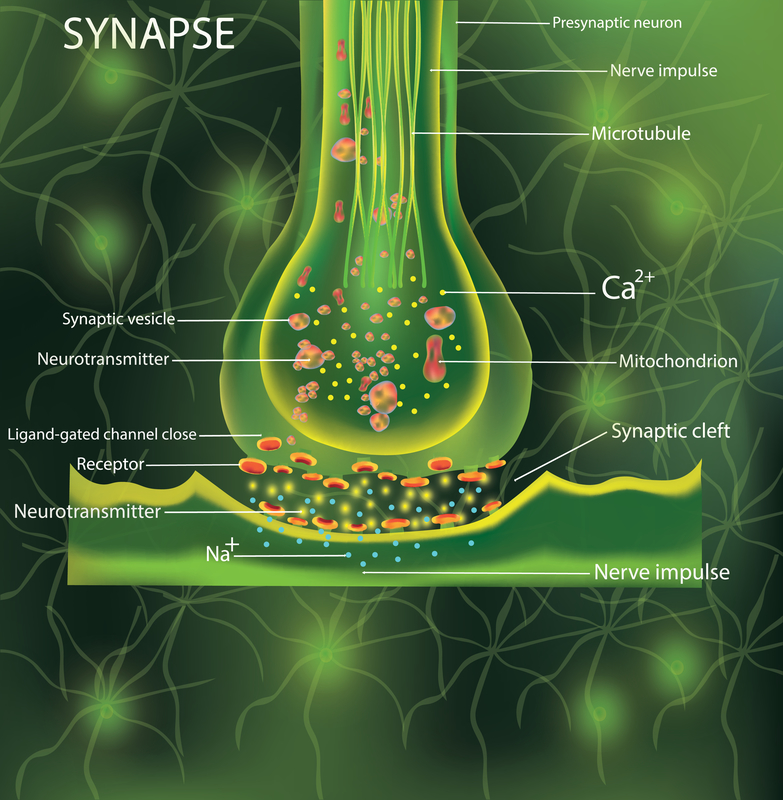12. Nerve cells
Contents of the chapter
12.1 The structure of a neuron
 The function of nerve cells is to sense and quickly transmit information in the body. A nerve cell that carries messages is called a neuron. The messages carried by neurons are called nerve impulses. Nerve impulses can travel very quickly, because they are electrical impulses.
The function of nerve cells is to sense and quickly transmit information in the body. A nerve cell that carries messages is called a neuron. The messages carried by neurons are called nerve impulses. Nerve impulses can travel very quickly, because they are electrical impulses.
All neurons consist of a cell center and one or more fibres. The cell center or soma contains the nucleus and other structures common to living cells. There are two kinds of nerve fibres: fibres that carry information towards the cell center, called dendrites, and fibres that carry information away from it, called axons. Nerves are tight bundles of nerve fibres. In most neurons, the cell center is connected to several dendrites but only one axon.
The fibres vary in length greatly. Some fibres are microscopic in size, whereas others are over 1 metre long. The longest cell in the human body links the central nervous system (the brain and the spinal cord) to other parts of the body.
Axons usually branch to connect to go to different neurons. Axon terminals at the end of axons make the actual connections with other neurons.
An axon terminal, as the name suggests, is literally the end an axon. A synapse is a structure which transmits (voltage/spike) information from one cell to another. Although they are often associated with each other, axon terminals and synapses are different, and you can have one without the other. The axon terminal contains neurotransmitters that can chemically transfer the nerve impulse to the next cell.
Some nerves are protected by a myelin sheath. Myelin provides the nerve with an insulating layer. The sheath protects the axon and allows electrical impulses to transmit quickly and efficiently along the neurons.
In multiple sclerosis (MS), the myelin sheath is damaged, causing nerve cells to malfunction. For example, the patient can develop visual and sensory impairments and experience muscle weakness.
Nerve cells are poorly regenerated in adults. However, the surrounding nerve cells can take on the role of a damaged nerve cell and form new connections with each other.

Left: A healthy myelin sheath with the corresponding nerve impulse. Right: A damaged myelin sheath with the corresponding nerve impulse.
12.2 Nerves
Several large nerves branch from the brain and the spinal cord to various parts of the body.
A typical nerve contains thousands of axons. These axons are wrapped in bundles called fascicles. Together with their surroundings supporting cells, the axons form a nerve cell bundle. Because nerve cells are living cells, they need oxygen and nutrients in order to function. Therefore, there are also blood vessels in the nerve.
In the central nervous system, axon bundles form tracts, whereas in the peripheral nervous system, axon bundles form nerves.

12.3 Neuron function
 Nerves are responsible for carrying messages around the body in the form of electrical impulses. The nerve cell can be stimulated by various impulses. For example, the photoreceptors in the eye's retina are stimulated by light, whereas touch receptors in the skin are stimulated by pressure.
Nerves are responsible for carrying messages around the body in the form of electrical impulses. The nerve cell can be stimulated by various impulses. For example, the photoreceptors in the eye's retina are stimulated by light, whereas touch receptors in the skin are stimulated by pressure.
The stimulus produces an electrical impulse in the nerve cell. This impulse travels along the nerve cell at a speed of more than 100 meters per second. When an impulse arrives at the axon terminal, a neurotransmitter is released. The neurotransmitter chemically transfers the stimulus to the neighbouring neuron.
Synapses are usually formed between axon terminals of the sending neuron and the dendrites of the receiving neuron. Inside the axon terminal of the sending cell, many synaptic vesicles filled with neurotransmitter molecules can be found. There is a small gap between the axon terminal of the sending neuron and the membrane of the receiving cell. This gap is called the synaptic cleft. When an electrical impulse arrives, a neurotransmitter is released into the synaptic cleft.
Many painkillers and anaesthetics prevent the transmission of nerve impulses across synapses. In other words, a stimulus that produces pain is created, but the information about it does not reach the brain and we do not feel pain.
12.4 Neurons form networks in the brain
 Each neuron contains multiple dendrites. These dendrites branch and form dendritic trees.
Each neuron contains multiple dendrites. These dendrites branch and form dendritic trees.
When we are learning something new, a neuron is stimulated to release neurotransmitters. These neurotransmitters make connections to other neurons and form a neural network.
The picture on the right shows a computer-produced image of a network of nerve cells. In the foreground, you can see the axon of the neuron.
